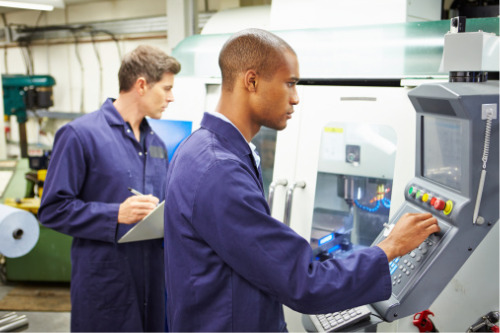

Returning to work for manufacturing operations in the United States after COVID-19 related shutdowns hasn’t been smooth sailing. According to the California Workers’ Compensation Institute, manufacturing has been the fourth most impacted industry when it comes to COVID-19 workers’ comp claims, with the sector making up 7.6% of total COVID-19 workers’ comp claims – the same percentage as the retail industry.
To assist manufacturing operations in reopening safely and mitigating exposures to their employees, AmTrust Financial Services has released its “Guide to Getting Back to Business,” which focuses in part on manufacturing-specific guidance.
Besides instituting regular hand-washing practices and the wearing of personal protective equipment (PPE), there are other ways that manufacturers can keep their staff safe during these uncertain times.
“Manufacturing as an industry has both advantages and disadvantages when it comes to arming itself against a pandemic like this. The advantages they have tend to center around the fact that they are an inherently safe industry in general, because they are dealing with risks that can have pretty severe consequences,” said Matt Zender, SVP of workers’ compensation strategy at AmTrust. “For instance, if you’re working with a machine that is 10 times your size, you’re going to pay attention to the safety training that you receive.”
Manufacturers also already have generally institutionalized practices and procedures regarding regular safety training, and they use buddy systems, as well as other methods, so that employees can look out for each other.
However, some of the disadvantages for manufacturers during this time are tied to these institutionalized behaviors. For example, there’s a certain amount of bravado that exists in manufacturing operations among all genders, where employees may believe they’re tougher and can withstand or avoid injury. In some cases, noted Zender, it’s also an industry that is dealing with a pace that can be quite quick and can challenge an employee’s ability to think about break times, or cleaning and disinfecting tools.
“We would encourage manufacturing operations to play off of their strengths and to give themselves a real hard look in the mirror to make sure that they’re not perhaps being ignorant to some other exposures that they have that they can realistically address,” Zender told Insurance Business.
Social distancing is one practice that may be difficult to implement at a manufacturing operation. Often, the layout of a plant is generations-old and revolves around maximizing efficiency. As a result, these layouts can be very expensive and complicated to change. This situation can cause some competing concerns, though Zender says that he believes it’s important to place both objectives on the table, and realize that, in many cases, they aren’t mutually exclusive.
“We have seen instances in manufacturing operations where the spread of COVID can transmit pretty quickly around a floor, and they are definitely more at risk than many operations due to the number of heads under a roof at one time,” he said. “But if you can’t maintain social distancing, maybe focus on barriers; if you can’t focus on barriers, maybe you have to stagger shifts, or you have to think about production in a slightly different manner.”
With some manufacturing operations potentially deciding to reduce the number of employees who are on the floor at one time, there may also be heightened exposures for staff who are taking on new responsibilities. AmTrust has seen instances where the expansion of roles and responsibilities can lead to increased injuries, which means that training becomes that much more important in this environment. “Once you’ve done that, you’ve built a lot of elasticity into your firm and you’ll have more manoeuvrability to move those employees throughout your operation,” said Zender.
For manufacturing operations – and companies from across industries – who are looking to get more insight on how to return their employees to work safely, AmTrust’s coronavirus-related resources are available for free to all policyholders.
“We welcome helping any policyholder, even those who are currently working with another insurance carrier, and, for that reason, much of our loss control content is not password-protected,” explained Zender. “We put as much as we can out into the public domain to help as much as we can, so we have a lot of information that we’ve been pushing out, including the ‘Back to Business’ guide, and we would encourage anyone who has questions to reach out to us.”
